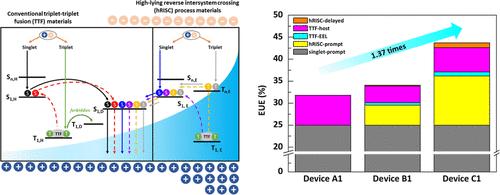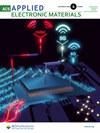Quantitative Analysis of Exciton Dynamics: Investigating the Role of the Efficiency-Enhancement Layer for Blue Fluorescent Organic Light-Emitting Diodes
IF 4.3
3区 材料科学
Q1 ENGINEERING, ELECTRICAL & ELECTRONIC
引用次数: 0
Abstract
One effective approach to overcoming the efficiency limits of triplet–triplet fusion (TTF)-based blue organic light-emitting diodes is to utilize the efficiency enhancement layer (EEL), which can increase efficiency through simple modifications in the device structure. However, the physical mechanism of the EEL, particularly exciton dynamics, has not been thoroughly investigated. In this study, the exciton utilization efficiency (EUE) was calculated by considering the host and EEL as individual emission components to analyze the exciton dynamics of the EEL. The materials that exhibit high-lying reverse intersystem crossing (hRISC) characteristics 2-(4-(10-(3-(9H-carbazol-9-yl)phenyl)anthracen-9-yl)phenyl)-1-phenyl-1H-phenanthro[9,10-d]imidazole (PAC) and 5-(4-(10-phenylanthracen-9-yl)phenyl)-5H-benzofuro[3,2-c]carbazole (ATDBF) were used as an EEL. The maximum external quantum efficiency (EQEmax) of the device without utilizing the EEL was measured at 3.0%. However, when PAC and ATDBF were utilized as the EEL in the device, the EQEmax significantly increased to 4.4 and 4.5%, respectively, resulting in an efficiency improvement of approximately 47–50% compared to when the EEL was not used. To ascertain whether the efficiency enhancement is induced through the hRISC process of the EEL, transient electroluminescence and magnetoelectroluminescence measurements were carried out. The results indicated that the triplets harvested into radiative singlets in the EEL device occurred through the TTF and hRISC processes. Finally, numerical simulations were carried out to evaluate the efficiency contributions from various mechanisms in the nondoped device, including TTF induced from the host (ηTTF.H), TTF induced from the EEL (ηTTF.E), and hRISC induced from the EEL (ηhRISC.E) in addition to 25% of EUE from singles via hole–electron recombination. The calculated ηTTF.H, ηTTF.E, and ηhRISC.E were 3.8, 0.6, and 4.7% for the PAC-based device and 5.5, 0.9, and 12.3% for the ATDBF-based device, respectively. Consequently, while the device using the host alone exhibited an EUE of 31.8%, the incorporation of PAC and ATDBF elevated the EUE to 34.1 and 43.7%, respectively, highlighting significantly enhanced EUE.

激子动力学定量分析:研究蓝色荧光有机发光二极管效率增强层的作用
要克服基于三重三重融合(TTF)的蓝色有机发光二极管的效率限制,一种有效的方法是利用效率增强层(EEL),它可以通过简单地改变器件结构来提高效率。然而,EEL 的物理机制,尤其是激子动力学,尚未得到深入研究。在本研究中,通过将宿主和 EEL 视为单独的发射成分来计算激子利用效率(EUE),从而分析 EEL 的激子动力学。研究采用了具有高位反向系统间交叉(hRISC)特性的材料 2-(4-(10-(3-(9H-咔唑-9-基)苯基)蒽-9-基)苯基)-1-苯基-1H-菲罗[9,10-d]咪唑(PAC)和 5-(4-(10-苯基蒽-9-基)苯基)-5H-苯并呋喃[3,2-c]咔唑(ATDBF)作为 EEL。在不使用 EEL 的情况下,设备的最大外部量子效率(EQEmax)为 3.0%。然而,当 PAC 和 ATDBF 用作器件中的 EEL 时,EQEmax 分别显著提高到 4.4% 和 4.5%,与不使用 EEL 时相比,效率提高了约 47-50%。为了确定效率的提高是否是通过 EEL 的 hRISC 过程引起的,我们进行了瞬态电致发光和磁致发光测量。结果表明,在 EEL 器件中,通过 TTF 和 hRISC 过程可将三重子收获为辐射单子。最后,我们进行了数值模拟,以评估非掺杂器件中各种机制的效率贡献,包括宿主诱导的 TTF(ηTTF.H)、EEL 诱导的 TTF(ηTTF.E)和 EEL 诱导的 hRISC(ηhRISC.E),以及通过空穴-电子重组产生的 25% 的单体 EUE。计算得出的 ηTTF.H、ηTTF.E 和 ηhRISC.E 分别为:基于 PAC 的器件为 3.8%、0.6% 和 4.7%,基于 ATDBF 的器件为 5.5%、0.9% 和 12.3%。因此,虽然单独使用主机的设备的 EUE 为 31.8%,但加入 PAC 和 ATDBF 后,EUE 分别提高到 34.1% 和 43.7%,突出表明 EUE 显著增强。
本文章由计算机程序翻译,如有差异,请以英文原文为准。
求助全文
约1分钟内获得全文
求助全文

 求助内容:
求助内容: 应助结果提醒方式:
应助结果提醒方式:


